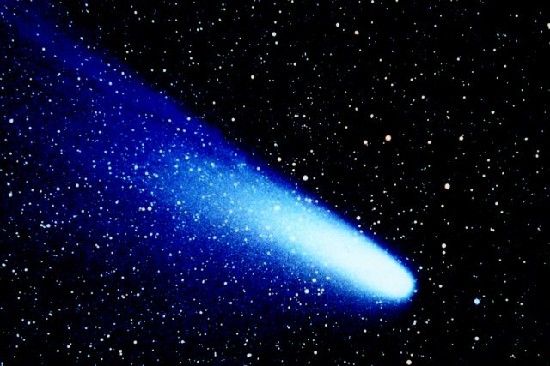But let's pretend again that we have made it to the Oort cloud. The first thing you might notice is how very peaceful it is out here. We're a long way from anywhere now—so far from our own Sun that it's not even the brightest star in the sky. It is a remarkable thought that that distant tiny twinkle has enough gravity to hold all these comets in orbit. It's not a very strong bond, so the comets drift in a stately manner, moving at only about 220 miles an hour.
但是,我們再作一次假設:我們已經到達奧爾特云。你首先注意到的是,這里非常寧靜。現在,我們離哪個地方都非常遙遠--離我們自己的太陽那么遙遠,它甚至算不上是天空里最明亮的星星。想一想啊,遠處那個不停閃爍的亮點是那么微小,卻有足夠的引力拖住所有這些彗星,這真是不可思議。這種引力并不很強,因此這些彗星只是很壯觀地慢慢移動,速度大約僅為每小時354公里。

From time to time some of these lonely comets are nudged out of their normal orbit by some slight gravitational perturbation—a passing star perhaps. Sometimes they are ejected into the emptiness of space, never to be seen again, but sometimes they fall into a long orbit around the Sun. About three or four of these a year, known as long-period comets, pass through the inner solar system.
由于引力的細微攝動--也許是由于一顆路過的恒星,在這些孤獨的彗星中,不時會有一顆被推出正常軌道。有時候,它們被彈進空蕩蕩的空間,再也沒有蹤影。但是,有時候它們會進入圍繞太陽的漫長軌道。每年大約有三四顆這類彗星,即所謂的長命彗星,從太陽系里側行通過。
Just occasionally these stray visitors smack into something solid, like Earth. That's why we've come out here now—because the comet we have come to see has just begun a long fall toward the center of the solar system. It is headed for, of all places, Manson, Iowa. It is going to take a long time to get there—three or four million years at least—so we'll leave it for now, and return to it much later in the story.
這些迷途的訪客只是偶然會撞上堅硬的東西,比如地球。這就是我們現在到這里來的道理--因為我們見到的那顆彗星剛剛開始朝著太陽系的中央經歷漫長的墜落過程。在這么多的地方中,它的方向偏偏是艾奧瓦州的曼森。它要花很長時間才能抵達那里--至少三四百萬年--因此我們先把它擱置一下,到本書快要結束時再來討論它。











